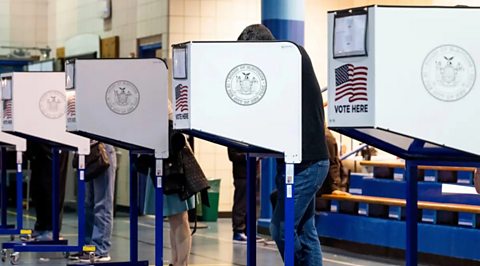How are women and minorities represented in US politics?
Quick version
- Women face challenges including media discrimination when entering into politics
- As well as gender discrimination, the responsibility of caring for a family is also regarded by many in American people as being a woman's role, therefore causing a barrier to higher political positions.
- People from many different ethnic groups live in the United States of America.
- The population is over 330 million and is increasing year-on-year.
Learn more
Women in US politics
How are women represented in American politics?
From the midterm elections in 2022:
- 25 out of 100 senators are women (25%)
- 126 of 435 members of the House of Representative are women (29%)
Women make up 15 percent of the Republican House delegation in the House of Representatives and 40 percent in the Democratic House delegation.
Women account for 18 percent of the Republican Senate delegation and 31 percent of the Democratic state delegation.
Source: US Department of State (April, 2024)
Of the 26 members of President BidenÔÇÖs cabinet, there are 13 women in high profile positions, including Vice President, Kamala Harris.
Source: The White House
What issues do women face in American politics?
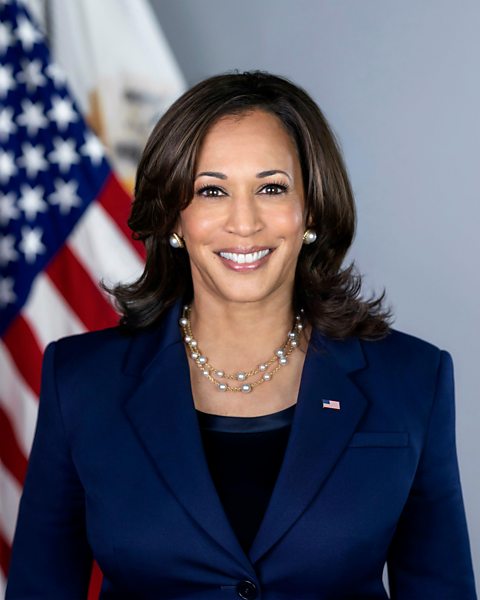 Image source, Alamy
Image source, AlamyAccording to research by the Pew Research Center in 2023, the American public sees differences in the way men and women running for higher office are treated by the media. Unlike their male counterparts, women candidates often receive negative publicity for showing emotion and having a young family.
This research also revealed reasons the American people see fewer women than men in high political office roles, including:
- Women having to prove themselves more than men
- Gender discrimination
- Less support for women from party leaders
- Public not ready to elect women into these positions
- Family responsibilities
A third say a woman president would do better than a man when it comes to:
- Handling education (46%)
- Handling health care (45%)
- Working out compromises (39%)
- Maintaining a respectful tone in politics (37%)
 Image source, Alamy
Image source, AlamyWhat is the population of the USA?
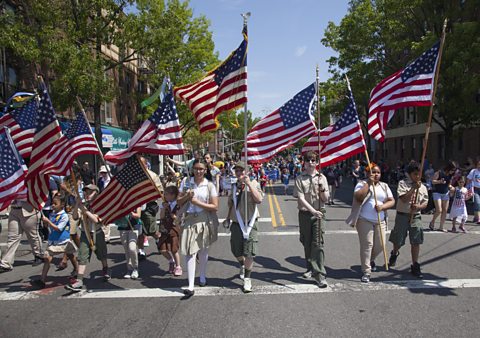
The United States is a country of many different groups of people.
The US Census Bureau estimated the US population on 1 January 2023 at 334.2 million people. The US population continues to grow and is expected to reach over 370 million by 2050.

At the 2022 US Census (based on July 1, 2022), the percentage population by ethnic group was:
- white - 75.5% (including 19.1% of Americans identifying as Hispanic or Latino*)
- black or African American ÔÇô 13.6%
- American Indian and Alaska Native ÔÇô 1.3%
- Asian ÔÇô 6.3%
- Native Hawaiian and Other Pacific Islander ÔÇô 0.3%
- Two or more races ÔÇô 3.0%
The US Census states that Hispanic or LatinoÔÇ»refers to a person of Cuban, Mexican, Puerto Rican, South or Central American, or other Spanish culture or origin regardless of race.
This means that those who identify as Hispanic, or Latino will be found in the groups above.
Around 19.1% of Americans identified as Hispanic in 2023.
How is the US population changing
The US population is growing steadily year-on-year. Going forward, the US Census Bureau predicts that the balance of different racial groups will change considerably by 2060.
In 2020, the US Census Bureau estimated the following:
- non-Hispanic white American population would fall to about 44.3% of the total US population.
- Hispanic Americans population would increase to about 27.5% by 2060, the total population would include:
- 15% black Americans
- 8.2% Asian Americans
- 1.5% Native and Pacific Island Americans
How much do minority groups participate in US politics?

Minority groups are becoming more important in US politics.
In most countries, the poorest people are less likely to participate in politics.
In the US, most ethnic minority groups are generally poorer than the white majority. They are also, historically, less likely to take part in politics, including using their vote.
Whites, on the other hand, are more to participate through:
- voting
- standing as a candidate
- joining a political party
- campaigning in local, state, or national elections.

What is voter turnout for minority groups in US elections?
Context: Barack Obama years
Barack ObamaÔÇÖs successful Presidential election campaigns in 2008 and 2012 were different to previous US elections.
They energised black American voters, with many people actively campaigning as well as voting.
Hundreds of thousands of volunteers donated money, organised transportation to voting booths, took part in telephone messages, or simply posted the motivational message Yes We Can, on social media.
65% of black Americans voted in the 2008 Presidential election, the highest figure ever.
Context: 2016 Presidential election
In the presidential election of 2016, voting turnout by racial group was similar to the years before Obama with white Americans turning out to vote in the highest percentage numbers.
Without Obama to vote for as President, the black American vote fell by seven percentage points from 2012. Around one percentage more white American voters turned out in 2016 compared to 2012. Both these changes favoured Donald Trump.
A survey for the Pew Research Center found that 88% of Donald Trump's voters were white, compared to 60% of voters for Hilary Clinton. 19% of Clinton voters were black, compared to 2% of Trump voters.
In the future, with minorities becoming a bigger percentage of the US population and voting in greater numbers, minority groups will become more important in deciding which candidate and parties win elections.
Turnout elections 2012, 2016 and 2020 by racial group
| Turnout / Race | 2012 | 2016 | 2020 |
|---|---|---|---|
| white | 64.1 | 65.3 | 70.9 |
| black | 66.6 | 59.6 | 62.8 |
| Hispanic | 48.0 | 47.6 | 53.7 |
| Asian | 47.1 | 48.4 | 59.1 |
How well represented are minority groups in America?
In the past, minority groups have been under-represented in US politics. This is changing although minority groups are still not represented in politics to their proportion in the population.
Kamala Harris is Joe BidenÔÇÖs Vice President and former Senator for California. She is the first black and first Asian American Vice President, as well as being the first female Vice President.
President Biden promised to make his Cabinet the most diverse in U.S. history, better representing the make-up of the country. Currently, 55% of US Cabinet members are non-white including Lloyd Austin as Secretary of Defense.
How are minority groups represented in US Congress?
Representation from ethnic minority groups has continued to increase in the US Congress.
The 118th Congress (from 2022 midterm election) is the most racially and ethnically diverse in the history of the country with 23% from an ethnic minority background. The majority of these are members of the Democratic Party (83%).
In 2023, of 100 Senators there were:
- 88 white-only senators although white Americans make up only 56% of the population
- 6 Hispanic senators although Hispanic Americans make up only 19.1% of the population
- 2 Asian senators although Asian Americans make up only 6.3% of the population
- 1 American Indian and Alaska Native make up 0.2% of the population.
In 2023, in the House of Representatives (435 members), there were:
- 313 white American-only congressmen/women (72% of all representatives) although white Americans make up only 56% of the population
- 53 black American congressmen/women (12.1%) although Black Americans make up 13.6% of the population
- 46 Hispanic American congressmen/women (10.5%) although Hispanic Americans make up 19.1% of the population
- 14 Asian American congressmen/women (3.2%) although Asian Americans make up 6.3% of the population.
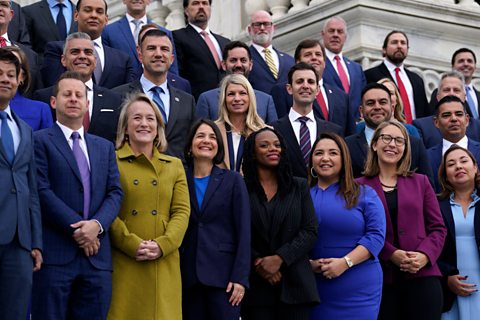
How are minorities represented on the Supreme Court?
There are nine Supreme Court justices. In 2024, three were from minority groups ÔÇô Judge Clarence Thomas, Judge Sonia Sotomayor and Judge Ketanji Brown Jackson.

How are minorities represented in state and local government?
There are many people from ethnic minority groups who have been elected at state and local level. However, minority groups remain, overall, under-represented at these levels.
Examples of locally minority group elected officials include:
- Governors such as Wes Moore the black American governor of Maryland and only the third black American elected as a governor in US history
- city mayors including Randall Woodfin in Birmingham, Alabama and Karen Bass in Los Angeles, California.
Quiz
Recap what you have learned
The US population is growing steadily year-on-year.
By 2060 the balance of different racial groups will change considerably.
Unlike their male counterparts, women in politics are often receive negative publicity for showing emotion or having a young family.
Of the 26 members of President BidenÔÇÖs cabinet, there are 13 women in high profile positions.
Most ethnic minority groups, who are generally poorer than the white majority, are also, historically, less likely to take part in politics.
As minorities become a bigger percentage of the US population, voting in greater numbers, minority groups will become more important in deciding which candidate and parties win elections.
Although it is changing minority groups are still not represented in politics to their proportion in the population.
Vice President Kamala Harris is the first black and first Asian American Vice President, as well as being the first female Vice President.
The 118th Congress is the most racially and ethnically diverse in the history of the country with 23% from an ethnic minority background.
There are nine Supreme Court Justices. Of this nine, currently four are female. In 2024, three were from minority groups ÔÇô Judge Clarence Thomas, Judge Sonia Sotomayor and Judge Ketanji Brown Jackson.
More on World power: USA
Find out more by working through a topic
- count5 of 5

- count1 of 5
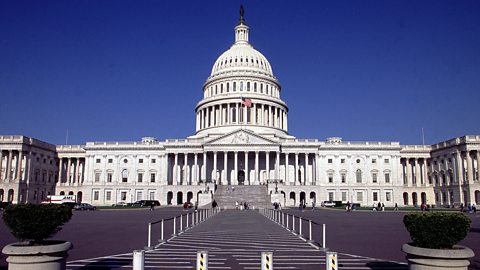
- count3 of 5
